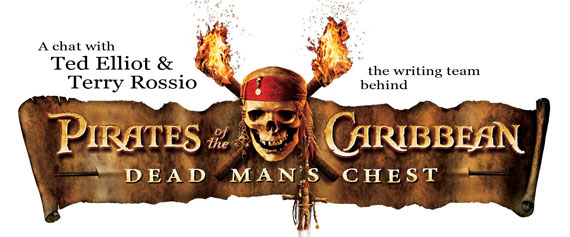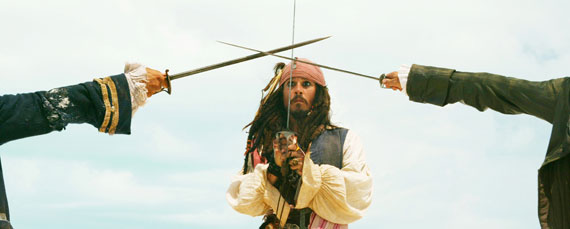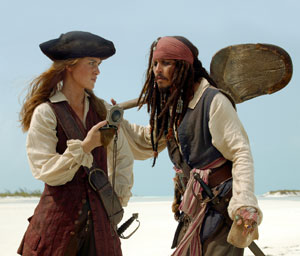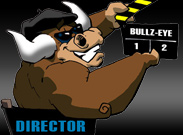
12/13/06
Movies Home / Entertainment Channel / Bullz-Eye Home
If you think Ted Elliot and Terry Rossio aren’t the foremost experts on cinematic pirate adventures, you must not have checked their résumés; the duo has composed the screenplays for the first two “Pirates of the Caribbean” films – “The Curse of the Black Pearl” and “Dead Man’s Chest” – and they’re currently hip deep in the post-production of the final chapter in the trilogy, “At World’s End.” In addition to the “Pirates” flicks, Elliot and Rossio have collaborated on “Shrek,” “The Mask of Zorro,” and Disney’s “Aladdin,” and Rossio joined forces with Bill Marsilii on the script for the recent Denzel Washington film, “Déjà Vu.” In conjunction with the release of “Pirates of the Caribbean: Dead Man’s Chest” on DVD, Elliot and Rossio chatted with Bullz-Eye for a few minutes on how they started working together in the first place, on their various team-ups, and how it’s a sucker’s bet to count on a sequel to a certain 1989 Howie Mandel/Fred Savage flick that they’re responsible for.
Bullz-Eye: Hi, guys.
Ted Elliot: Hey.
Terry Rossio: Hi, Will!
BE: Good to talk to you.
TE: You know, as we’ve been talking to people, we’ve been going to their websites…and I have to say, Bullz-Eye has the best opening page.
BE: I’m glad that you like it.
TE: (Laughs)
BE: We get a lot of positive feedback on that. Well, I guess I’ll open with the question everyone does: now that America has fallen in love with Howie Mandel all over again, have you been commissioned to write “Little Monsters 2”?
TR: (Laughs)
TE: (Laughs) No, you know, I think Pixar’s “Monsters, Inc.” has made the definitive statement on monsters, and we can move on with our lives.
BE: Well, all right. I don’t know if I can, but all right. Seriously, though, “Little Monsters” was your first collaboration, correct?
Both: Yes.
BE: How long have you known each other?
TE: Actually, since high school. We actually met in high school journalism class.
TR: Now, how long ago was that? Well, who knows at this point?
TE: Let’s see, that’s been…
TR: (Interrupts) Let’s not put a number to it, shall we?
TE: (Laughs) It’s been a while!
BE: Were either of you writing solo at all prior to that?
TE: No, actually, we sort of decided to become screenwriters as partners. It was a little bit of kismet in action there.
TR: Truth be told, we didn’t really put a lot of thought into it.
TE: Yeah, I know, we really didn’t. We just went, “Hey, you wanna write a screenplay together?” “Yeah, okay.”
TR: Yeah, that was about the extent of the strategizing…and, y’know, one thing led to another, and here we are. It all made sense at the time, I guess. Who can tell?
BE: When you wrote the script for the first “Pirates of the Caribbean,” did you think it was going to be a blockbuster, or did you just have high hopes but no dramatic expectations?
TE: Well, it was one of those things where when we were making the movie, we were down in St. Vincent’s, and we were really under the radar. I mean, people who had heard about the movie being made were, like, “You’re making a pirate movie? Really? Based on an amusement park ride? Really?” But everybody working on it felt like, “We’re making a good movie.” But there’s always the question. You never know, until it’s in front of an audience, what the audience is going to think. So we were confident we were making a good movie, and we were also confident that if there was any possibility at all that a pirate movie could be successful, this one would be. But… (Laughs) …there was still the big question: are we right?
TR: It’s very strange, because so much of designing a film is theory, and, in theory, every film we design should be a hit. (Laughs) You know? Like, it really should. They’re designed to do what they should…do. I mean, obviously, there’s a huge aspect to execution, direction, effects, acting, and all of that, but, in theory, it should work. But as you’re making it, you’re made to feel like all you’re doing is dealing with problems. The actual experience of it is endless problem solving. Well, after several months of endless problem solving, you start to feel like, “Well, this film is just one big problem, so what are the odds that it’s really going to be successful?” So there’s definitely a lot of push-pull going on there.
BE: When you’re writing roles in your scripts, how much do you tend to describe characters as a such-and-such type? I mean, did you write Jack Sparrow by saying that he was “a Johnny Depp type”?
TE: Well, when we were working on the first movie, when we came on, we knew that Johnny had been talking to Disney about doing a movie, and they were, like, “Well, what about ‘The Haunted Mansion’ or ‘Pirates of the Caribbean’”? And he was kind of interested. So knowing that Johnny’s a pretty smart, somewhat eccentric actor, it gave us license to push the character further than we might’ve otherwise done. But it really is a joy writing for Johnny, because…he gets it! I mean, that’s the great part. We never have to worry about sitting down and having to explain the line to Johnny Depp.
TR: Yeah, character design is such a collaboration, with even something like the costume design or the make-up, certainly the direction and editing choices, and the generosity of other actors…it really is the amazing aspect of the art form, that it brings together so many people with so many levels of expertise, to come up with a finished thing, either a character or the story.

BE: So is Keith Richards indeed playing Jack’s father in this third film, or is he playing a different character?
TE: (Hesitates) Keith Richards is in the third film, as a character…but we prefer to keep the relationship ambiguous.
BE: Ah.
TE: How’s that?
BE: Fair enough. You guys wrote “Shrek,” but you didn’t write “Shrek 2.” Were you even asked, or did you submit an idea that they passed on…?
TE: We did a little work on “Shrek 2,” but we…there was a difference in the, uh, creative direction. The story they went with was sort of a variation on “Guess Who’s Coming to Dinner,” and my problem with that was that, in “Guess Who’s Coming to Dinner,” the father is the guy who makes the plot work, not the guy who comes to dinner. And I think that’s reflected in “Shrek 2.” Shrek does not really motivate the story.
TR: Yeah, we had…even with that direction that they went, we ended up contributing to the story, in terms of character creation, plot elements, and that kind of thing. But we’re on there as “creative consultants.”
BE: When you wrote “Shrek,” did you feel like you were finally getting away with making the jokes that you couldn’t get away with in your Disney scripts?
TE: Well, you know, it’s interesting, because the identity was the same; it was Jeffrey Katzenberg at Disney, and then it was Jeffrey Katzenberg at Dreamworks. And part of what we were doing with “Shrek” was intentionally kind of refuting the…I don’t want to say “formula,” because that’s not quite it, but the formula that the Disney films operated on, which were…there were certain little restrictions and ideas about how those stories had to be. So it was kind of fun, actually, on “Shrek” to say, well, no, you can do…well, the real motive for “Shrek” was this: let’s do an animated movie that’s just flat-out funny. Let’s do a cartoon. How about that? (Laughs)
TR: Yeah, whenever you work on these films, you work with these story artists who sit around the table, and they do all these funny little sketches in the course of the meetings. And part of the idea of “Shrek” was to take all of those hilarious sketches and put ‘em in a movie.
TE: Yeah, they’re making jokes about the movie they’re working on. And it was, like, man, it’d be so great to actually do a movie where you could actually keep those jokes in!
BE: Terry, you wrote with Bill Marsili on “Déjà Vu.” Was it weird collaborating with someone different after spending so much time writing with Ted?
TR: The thing about “Déjà Vu” was that it took seven years to write that script.
TE: (Laughs) That must have been different!
"We were confident that if there was any possibility at all that a pirate movie could be successful, this one would be. But there was still the big question: are we right?"TR: Yeah, but in a way, it wasn’t weird because it was so ongoing. It was just odd because it took so much time. It was certainly a departure, but, y’know, it was such a compelling story, and it was really compelling to work on.
BE: On the Internet Movie Database, you two have a ton of different types of writing credits attributed to you, including “Story,” “Screen story,” “screenplay,” and “written by.” What exactly is the difference? Is it sometimes a rough plot sketch, or in other cases a situation where you wrote an early draft but only a small amount made it into the final version?
TE: It really just comes down to…essentially, if you see a movie where there’s been writers on it, there’s two things that are required to make a movie: there’s a story to be adapted into the movie, and then there’s the dramatization that’s performed and actually copied and recorded in the movie. And that’s the distinction. A story is a story, or a screen story – again, it’s the story that underlines the dramatization of the movie – and then the screenplay is the dramatization. So it really depends on what work you’ve been asked to do and what work you’ve contributed. So, basically, if you see a screenplay credit, it means the person contributed dramatization. Story credit means they’ve contributed the story. (Laughs) How’s that? As simple as that! (Laughs)
BE: Do ya’ll have anything else in the works at the moment?
TE: Not really. We’re kind of looking forward to finishing “At World’s End,” because it’s been…we’ve been working on these “Pirate” movies – “Dead Man’s Chest” and “At World’s End” – for more than two years. And that’s a long time! Nobody ever said I’d have to have regular employment; that’s not why I got into the business! (Laughs)
BE: Oh, and I meant to ask this a minute ago: do ya’ll have a preference as far as writing original screenplays over adaptations? Because, for instance, I know that one of your earlier scripts was an adaptation of “The Puppet Masters,” the Robert Heinlein story.
TE: Um…it’s…I don’t really have a preference, do you, Terry? We’ve never really talked about this! It’s a good question!
 TR: Well, what happens is…y’know, originals are fun, we have those ideas, but what happens, practically speaking, is somebody comes along and there’s this window of opportunity, and they say, “Do you want to do a ‘Zorro’ movie?” “Yeah!” “Do you want to do a pirate movie?” “Yeah!” So…how do you turn that down? Like, when we worked on “Men in Black,” it was, like, well, that’s an interesting idea. Or working for Spielberg. Or even Godzilla! Our “Godzilla” script, which didn’t get shot, was still an interesting thing to do. So it’s, like, how do you turn down something? It’s a lot easier to push back from doing something original than it is to pass by doing something where the opportunity is there and it may not come back.
TR: Well, what happens is…y’know, originals are fun, we have those ideas, but what happens, practically speaking, is somebody comes along and there’s this window of opportunity, and they say, “Do you want to do a ‘Zorro’ movie?” “Yeah!” “Do you want to do a pirate movie?” “Yeah!” So…how do you turn that down? Like, when we worked on “Men in Black,” it was, like, well, that’s an interesting idea. Or working for Spielberg. Or even Godzilla! Our “Godzilla” script, which didn’t get shot, was still an interesting thing to do. So it’s, like, how do you turn down something? It’s a lot easier to push back from doing something original than it is to pass by doing something where the opportunity is there and it may not come back.
TE: And there’s also just from the point of view of…y’know, I became a screenwriter not necessarily to be a writer but to be a filmmaker, and I knew they needed writing. And if the studio is already invested into a project more than just the cost of the literary material – the story or the screenplay – there’s a higher chance that movie will actually go into production and there’ll be a film made. So that’s part of why we sort of look towards properties that the studios already spent some money on. That’s the way to gauge their level of commitment.
BE: Well, I know you guys are probably exhausted if I’m your last interview, but I appreciate getting the chance to talk to you.
TE: Great talking to you.
TR: Thanks, Will!
You can follow us on Twitter and Facebook for content updates. Also, sign up for our email list for weekly updates and check us out on Google+ as well.







